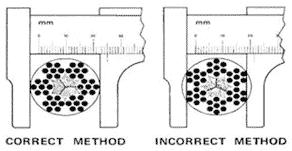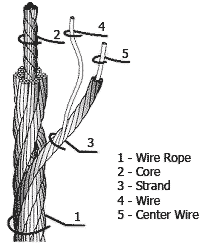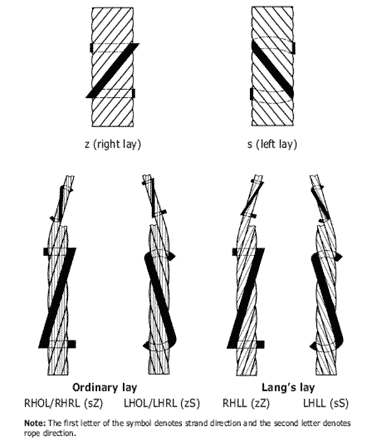The properties of wire rope are derived from its size, construction, quality, lay, type of core and finish.
Size
Ropes are referred to by a diameter size. The correct way to measure wire rope is shown below.

Construction
 The main components of a wire rope are shown to the right. In the example above, each individual wire (4) is arranged around a central wire (5) to form a wire strand (3). Strands (3) are formed around a central core(2) to make a wire rope(1). The actual range of wire rope constructions is wide and varied but the number can be limited to approximately twenty five. Below are some examples. The size and number of wires in each strand, as well as the size and number of strands in the rope greatly affect the characteristics of the rope. In general, a large number of small-size wires and strands produce a flexible rope with good resistance to bending fatigue. Ideal for running or moving ropes such as winches, hoist and luffing type applications. A fewer number of thicker wires and strands produce a less flexible rope with good resistance to abrasion and corrosion. These are ideal for scraper, staying and standing type applications. The rope construction is also important for tensile load (static, live or shock) abrasive wear, crushing, corrosion and rotation.
The main components of a wire rope are shown to the right. In the example above, each individual wire (4) is arranged around a central wire (5) to form a wire strand (3). Strands (3) are formed around a central core(2) to make a wire rope(1). The actual range of wire rope constructions is wide and varied but the number can be limited to approximately twenty five. Below are some examples. The size and number of wires in each strand, as well as the size and number of strands in the rope greatly affect the characteristics of the rope. In general, a large number of small-size wires and strands produce a flexible rope with good resistance to bending fatigue. Ideal for running or moving ropes such as winches, hoist and luffing type applications. A fewer number of thicker wires and strands produce a less flexible rope with good resistance to abrasion and corrosion. These are ideal for scraper, staying and standing type applications. The rope construction is also important for tensile load (static, live or shock) abrasive wear, crushing, corrosion and rotation.
Cores
A number of core types are available and each ahs specific properties: 1.Wire strand core(WSC)- The core is usually of the same construction as the outer strands. 2.Fibre core (FC)- These are normally sisal or polypropylene. 3.Independant wire rope core (IWRC)- a wire rope usually of 6x7(6/1) / 1x7(6/1) construction.
Wire Strand Core (WSC)
A fibre core, generally sisal, provides a resilient foundation for the strands in the rope structure. Fibre cores are used for ropes where flexibility in handling is required. Fibre Cores are inadequate where ropes are subjected to prolonged outdoor exposure and crushing on small drums and sheaves.
Fibre Core (FC)
These cores are used chiefly for standing ropes(guys or rigging), and offer high tensile strength and, owing to the larger wire is the core , greater resistance to abrasion.
Independent Wire Rope Core (IWRC)
Independent wire rope cores are preferred for operating ropes in applications of high tensile stress, high compression loads on small drums and sheaves ( such as earth moving equipment) and high operating temperatures ( such as cranes handling molten metal). A rope with an IWRC is approximately 11% heavier and 7.5% stronger than fibre cored rope of the same size.
LAY
 This refers to the way the wires in the strands, and the strands in the rope are formed into the completed rope. The wire strands are essentially laid up in a planetary motion with controlled twist being imparted to produce a tightly formed rope.
This refers to the way the wires in the strands, and the strands in the rope are formed into the completed rope. The wire strands are essentially laid up in a planetary motion with controlled twist being imparted to produce a tightly formed rope.
The term "lay" is used in three ways:
- To describe the direction in which the strands are laid in the rope, right or left. In a Right Hand lay strands are laid around the rope core in a clockwise direction - see illustration below. In a Left Hand lay, the strands are laid anti-clockwise - see illustration below. Steel Wire Ropes are conventionally produced Right Hand lay unless special circumstances require Left Hand lay.
- To describe the direction in which the wires are stranded in relation to the direction of the strands in the completed rope, e.g. Ordinary lay or Lang's lay. Ordinary lay means the wires in a strand are laid in a direction opposite to the direction in which the strands are laid in the final rope. Lang's lay is the reverse of Ordinary lay. That is, the wires are laid in the same direction as the strands in the rope. Lang's lay ropes have superior properties in resistance to wear, abrasion, fatigue and scuffing. This is illustrated below, where it can be seen that wear on an outer wire is distributed over a far greater area than in Ordinary lay.
- Lay" is also a measure of the pitch of a strand in a rope.
Lay Directions & Types
Lay direction of strands for stranded ropes are right (z) or left (s) and correspond to the direction of lay of the outer wires in relation to the longitudinal axis of the strand. Lay direction of ropes are right (Z) or left (S)and correspond to the direction of lay of outer wires in spiral ropes, the outer strands in a stranded rope or the unit ropes in a cable-laid rope in relation to the longitudinal axis of the rope.
Characteristics of lay
 The direction of rope lay does not affect the breaking force of a rope. However, the combination of strand lay and rope lay will greatly affect the rope characteristics and this factor must be taken into consideration when choosing a rope. Although the lay length can slightly affect rope behaviour the dominant aspect that influences performance is the direction of lay and whether it is Lang’s lay or Ordinary lay.
The direction of rope lay does not affect the breaking force of a rope. However, the combination of strand lay and rope lay will greatly affect the rope characteristics and this factor must be taken into consideration when choosing a rope. Although the lay length can slightly affect rope behaviour the dominant aspect that influences performance is the direction of lay and whether it is Lang’s lay or Ordinary lay.
For example, the importance of rope lay is evident in a four-part high lift grab where rotation of the grab is prevented by the use of alternative right-hand and left-hand ropes.
Steel Quality-Tensile Strength
Wire Drawing technology passed on from generation to generation, new equipment and stringent quality control in rod selection , wire drawing and closing ensure that our wire rope conform to Australian and international specifications.
Wire ropes are commonly supplied in the following tensile ranges:
| Rope Grade N/mm? |
|---|
| 1570 |
| 1770 |
| 1960 |
| 2160 |
Galvanised ropes and strand are made of zinc coated (galvanised) wire rope for protection against corrosion. With the increasing use of heavy-duty and more compact equipment( e.g. power winches on mobile cranes and mine winders) there is a gradual upward trend in the required rope wire tensile range. However, as factors other than strength influence the life of wire rope, the specific application must be kept in mind when the tensile strength of the wire is selected.
Quality Control
All our ropes are produced to comply with the requirements of the Australian standards. These standards require ropes to be produced to AS3569. Our ropes comply with these specifications and internationally recognised specifications. Our companies testing facilities are constantly engaged in the testing of both works production and samples received for examination. For investigation and customer service purposes, a non destructive testing unit is available. Enquiries concerning use of this instrument or advice on non-destructive testing in general are welcome. A full report of all site examinations is issued.
Note: Inspections must be carried out by competent individuals. If in your opinion, a wire rope has sufficient damage of any type that may result in an accident or injury, don’t use it, tag the wire rope “OUT OF SERVICE” and have it inspected or replaced.
Wire Rope Terms
Minimum breaking Force (MBF)
In published material, wire rope strength is shown as minimum breaking force (MBF) referring to the calculated strength figures that are accepted by the wire rope industry. They are usually based on the use of wires of a nominal size and the minimum tensile strength or as in Europe these figures are based on an aggregate MBF, based on cross sectional area and tensile strength of wires only. The MBF is the figure which should be used for design of rope equipment.
Diameter
The measurement across the centreline of the circle circumscribing the outer wires of a strand or the outer strands of a rope.
Design Factor/Safety Factor
Term applied to the required ratios of rope breaking force to total rope force due to load and is normally set by statutory bodies.
Working Load Limit
The working load limit is the maximum load a rope can carry on a particular service. The WLL should be based on the MBF, not the actual breaking force, which can vary depending on construction and size. The design factor /safety factor for ropes in Australia under general conditions is 6:1. This may vary in certain circumstances such as an ‘engineered lift’, where design factor may be reduced if approved. Crane manufacturers may also choose to use higher design factors for certain ropes on certain crane models, as such if you are not sure always refer back to us or to the manufacturers specification. Due account should be taken of the number of parts and the efficiency, whenever the design factor of a system is being determined. Regulatory authorities or other Standards may require other design factors.
Wire rope selection guide
When selecting a rope, if you are not sure of the exact requirements please provide your AR&R Representative with:
- Length and size
- Load Centre of Gravity
- Working load limit
- Model of equipment to be fitted by rope
- Load exclusive of mass of rope.
- Dimensions of drums and sheaves
- Corrosive conditions
- Sketch or drawing of the application Special aspects of rope supply may be necessary.
The following checklist is suggested:
- Special length considerations such as minimum length, exact length.
- Special diameter tolerance.
- Rope end preparation
- Hairpin wound onto reel or straight.
- End attachments to inside or outside of end.
- Stretch considerations
- Special lubricant type and amount
- Special reel dimensions, strength shaft sizes, anchorage details, lagging and flange and drum sizes.
- Despatch instructions
Notes on Tables for Mass and Breaking Force
The following tables show rope mass in “kg per metre” and breaking force in “Kilo newtons” for the various constructions and categories of Wire Rope. Please note that the value varies from category to category since the various constructions contain different steel areas and variable losses occur in the wire stranding process. Wire quality has been nominated in 1570,1770,and 1960 grades for the majority of wire ropes, the value 1570, 1770 etc. corresponds to the minimum tensile strength of the wire expressed in mega Pascals. Marine ropes have been nominated at 1570 grade and general engineering ropes both un-galvanised and galvanised are nominated in 1770 grade. To calculate the approximate MBF equivalent in tons divide kilo newtons by 9.81.
Example: 13mm 6x19 Fibre core Ungal. 1770mpa = 98.71kn = 98.71 = 10.06 Tonnes 9.81
